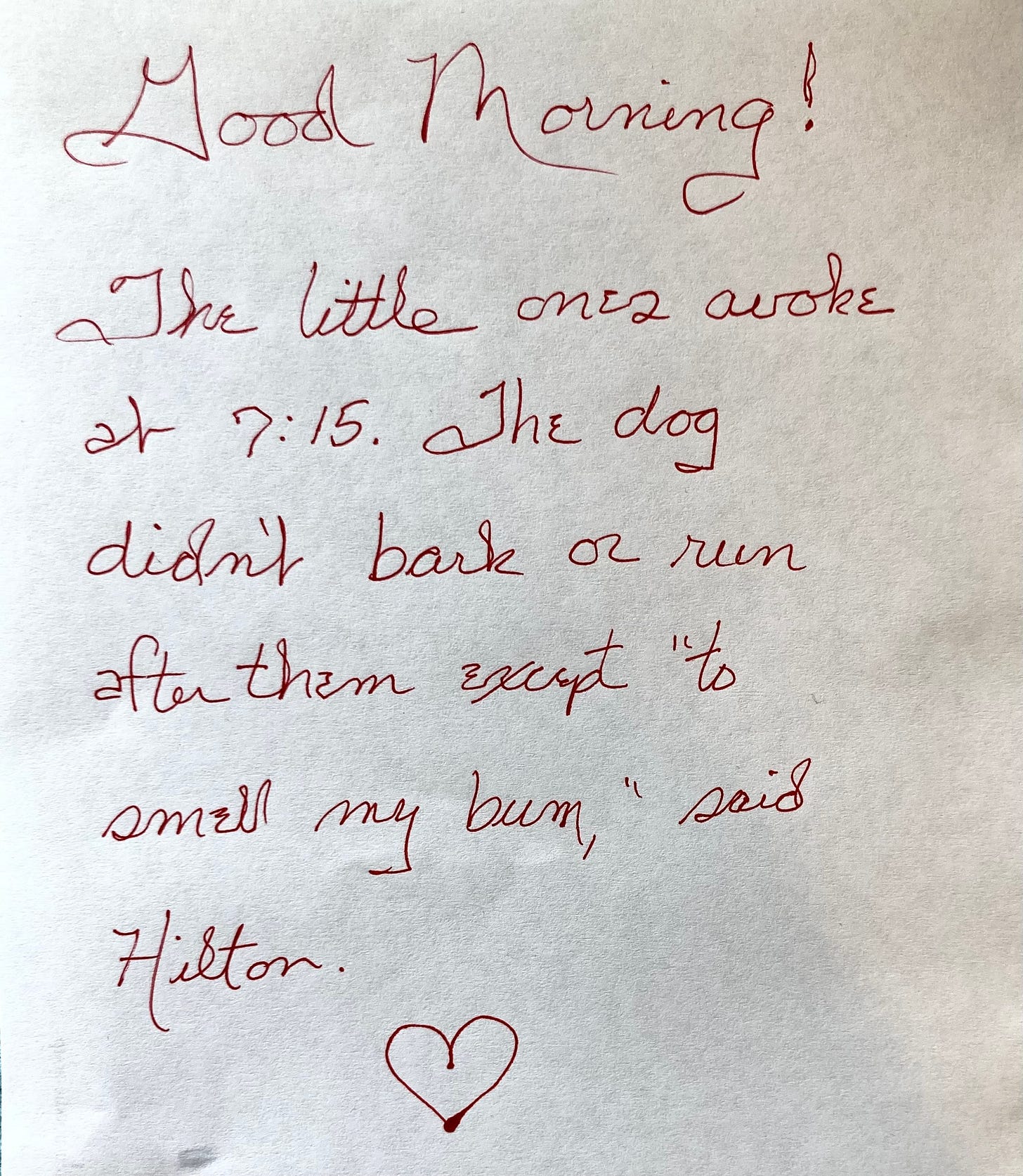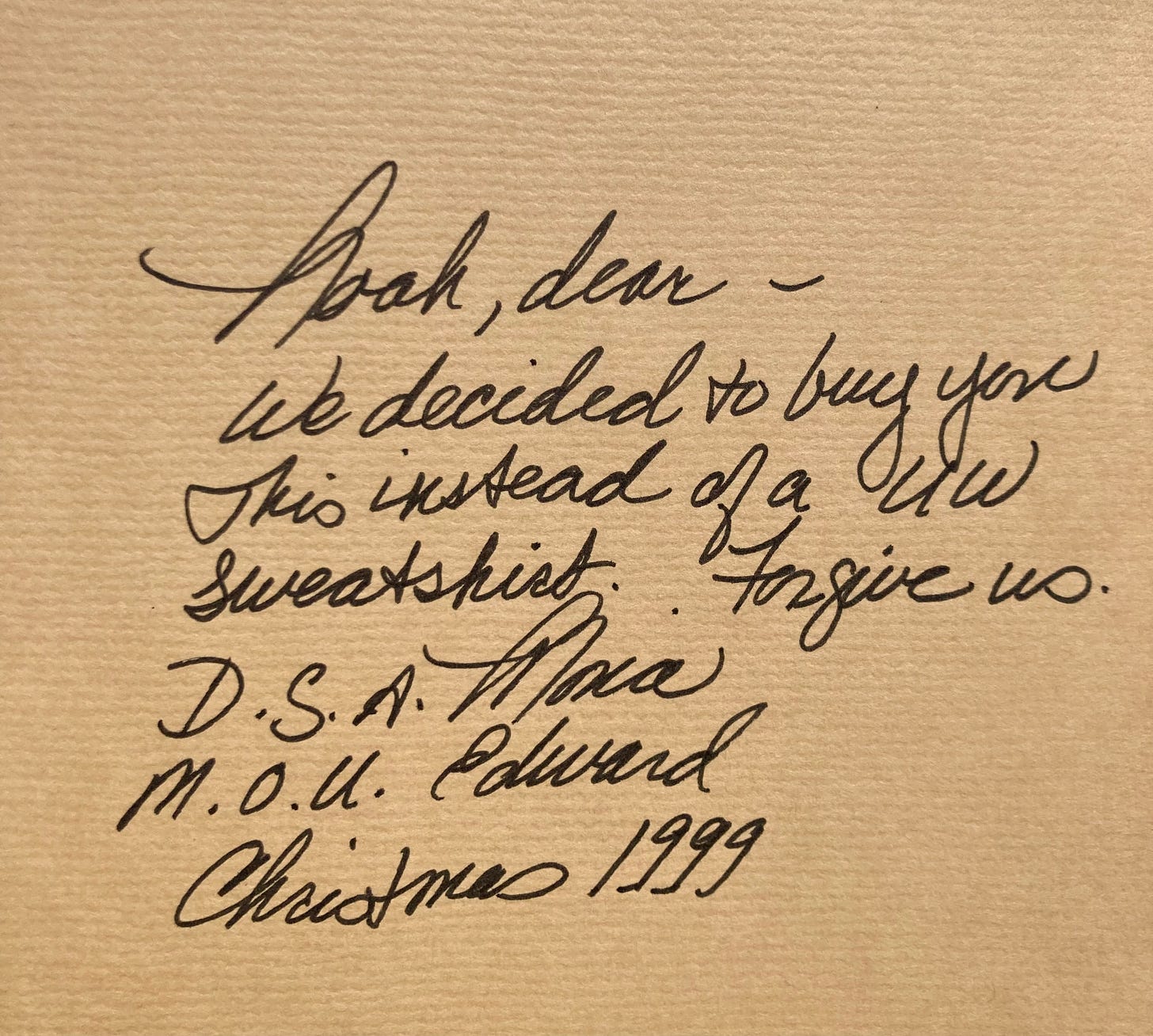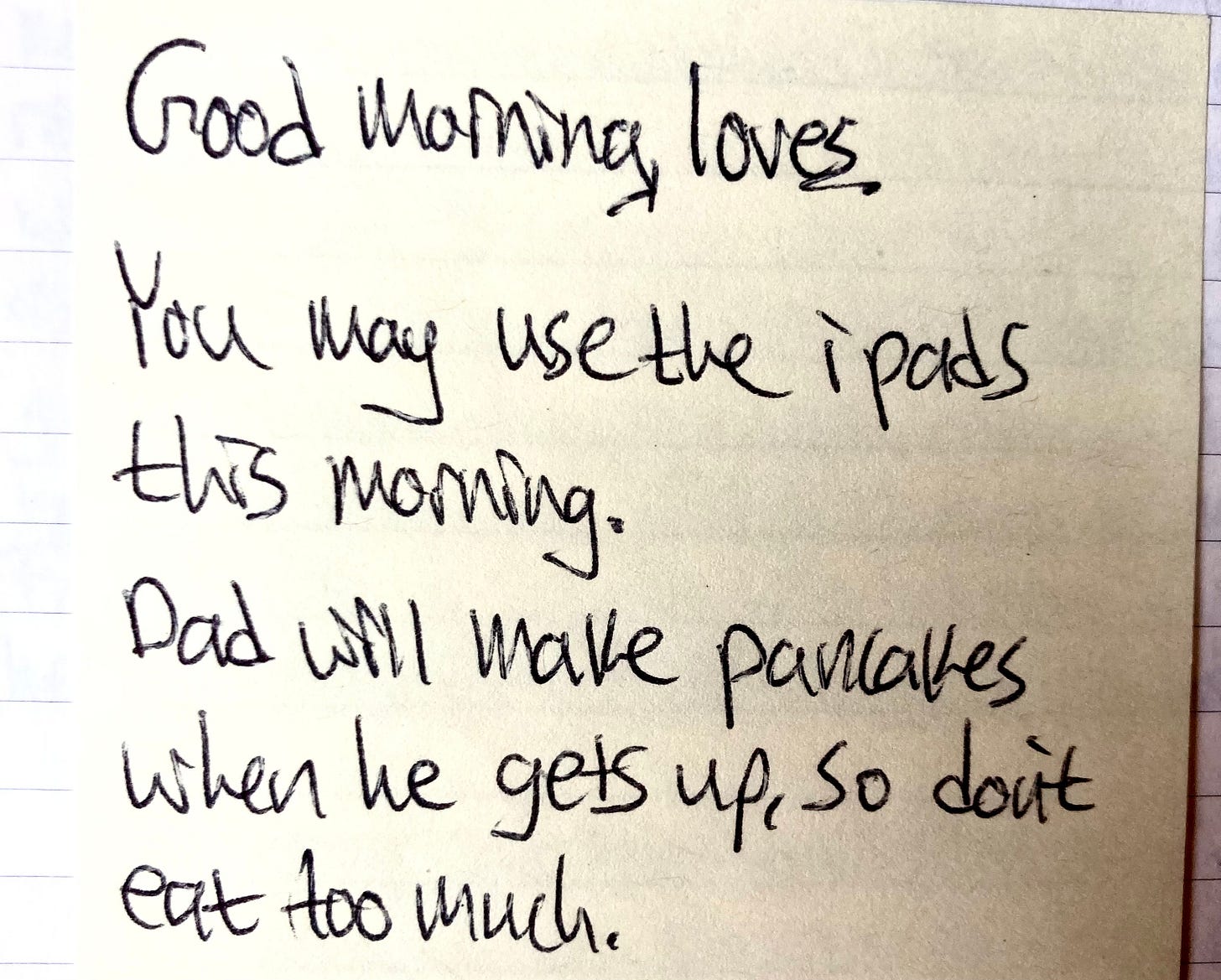The children and I are in Minnesota, where my wife and I grew up. We fly here every summer to expose them to this grass, this water, and to see our loved ones in person.
On our second morning, my mother left me this note.
She learned her handwriting in Catholic schools. “But I worked to develop my own style,” she told me. “It got me in trouble with some teachers.”
We also drove to Wisconsin to celebrate the life of my aunt Moria. She was the first woman judge of Dane county. She gave me many books over the years, with inscriptions like this one, written in a copy of Benet’s Reader’s Encyclopedia.
I am very glad to have these messages, now that she is gone.
I never learned to write as well as her, or my mother. But I also developed a style. This spring, I wrote my children a note like this every morning.
For many years, it was believed that the quality of a person’s handwriting correlated highly with their intelligence. Prospective teachers were evaluated for their demeanor with children, their organization, the grades they received in training, and their handwriting. Now, we know handwriting can’t predict intelligence or teaching ability.
Nevertheless, it makes me sad to think that my own children are unlikely to develop beautiful script. Handwriting instruction has been significantly de-emphasized in public schools since the 1990s. Children still learn to print, but with more flexibility, and less feedback. Less direction, less concern for accuracy. Cursive instruction is done grudgingly. Many find it worthless.
I asked to see some handwriting of my grandmother, Rosemary. My mother found this letter she wrote to her husband, Hilton, when he was stationed in the Pacific.
We should change, as times change, what we teach. Shorthand is no longer necessary. Learning statistics is probably more important, on average, than learning calculus.
We’re in a new era of education reform. One that seems more values-based, and more partisan, than the previous era of standards-based reform. So far, phonics is back in style, as is tutoring. Math is ripe for change. AI is destroying the essay.
Will handwriting have its renaissance? I think by its utility, its beauty, and its ability to close the distance between us, it should endure.
News
Thoughts on the week’s education stories. Pushback welcome.
LAUSD shelves its hyped AI chatbot to help students after collapse of firm that made it
The unthinkable has occurred: a tech startup has collapsed. That’s not news; disruption and change are part of that industry’s culture. What’s news is when system leaders adopt this culture. They should only do so if the status quo is truly broken.
New Indiana ‘Checkpoint’ Tests To Give Mid-Year Snapshots of Student Progress
These kinds of tests are a strong accountability lever, and systems leaders will be glad to stop paying outside vendors. But the state is not the right level for developing useful assessments. Teachers are right to be tired of tests designed mainly to predict how students will do on other tests.
Detroit teachers union members approve new two-year contract with school district
While teaching, I often preferred working in non-union schools. It’s complicated with public sector unions. But every theory of change I believe in requires teachers make a higher salary, and I know of no mechanism for ensuring this better than union organizing.
Schools Got a Record $190 Billion in Pandemic Aid. Did It Work?
Our education system is a 50-state, 13,000-district fractal. Nobody is in charge of it. The best we can do is learn from our grand experiment. Ensuring we learn is an appropriate role for the federal government, especially when it is giving out money. Common coding of expenditures should have been a requirement.
New Mississippi Law Makes ASL a Foreign Language Credit
A good idea, coming directly from a teacher, now enshrined into law. Useful policy with bipartisan support. Let Mississippi surprise you.
Highly Satisfactory
The best grade you could get in Mrs. Bogie’s Kindergarten class.
Sahan Journal is a non-profit journalism site based in Minneapolis that centers “the experiences of immigrants and communities of color” in their reporting. Their education stories, covered almost single-handedly by Becky Dernbach, stand out to me for one reason: she interviews parents and teachers.
Here, she quotes a parent speaking about the impact of proposed cuts to Somali language programs in Minneapolis Public Schools.
“Even if it was in Owatonna, I would drive my kid,” Muna said of the heritage language program.
Hurio said that she had grown up in the United States and did not know every Somali word.
“Half of the time I feel like I don’t fit into my own community,” she said. “I don’t want my kiddo going through that.”
As the story notes, the proposed cuts to these programs were rescinded. That reminds me of another way Sahan Journal stands out: sometimes, they have good news.







Would prefer to leave a handwritten response, but this will have to suffice. I was eager to learn cursive so I could join my four older siblings in this ‘advanced’ form of communication. In my Catholic school (moons ago), writing was introduced in third grade. It signified growth. I echo the previous comments on your addition of news commentary. There’s a plethora of stories, theories, concepts awaiting your thoughtful, unbiased assessment.
I absolutely love the case you make for beautiful handwriting (and its gradual fading from our educational system). I read more carefully (and keep) ANY card or letter that is handwritten. (I probably haven’t received a handwritten letter from anyone since my mother died in 2006.)
And I also love the educational news summary. Please keep that coming, if you have the time and energy to do it.